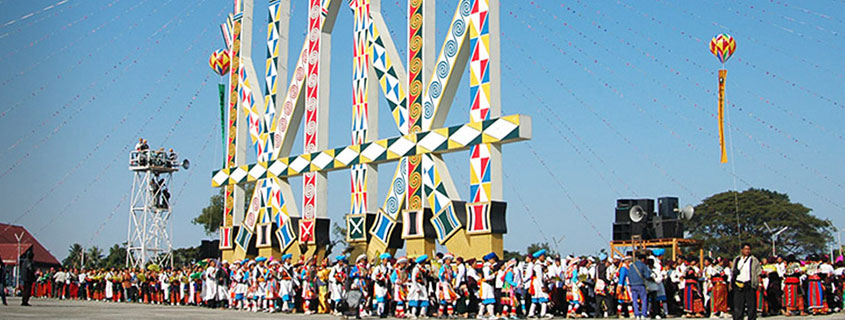
Myitkyina, the capital, and Bhamo are the chief towns. Rice and sugarcane are grown, jade and amber mined, and timber and bamboo cut. The state is sparsely populated; Jinghpaw-speaking Kachins constitute the largest group. They maintain tribal forms of organization under chiefs, practice shifting cultivation, and are mostly animists or Christians. The territory was never subject to the Burman kings, and after the establishment of British rule it was governed directly, not as part of British Burma. The territory was invaded (1945—47) by the Chinese, but a border agreement was signed between Myanmar and China in 1960. Antigovernment insurgents, active in Kachin State since Myanmar achieved independence in 1948, signed a cease- fire agreement with the government in 1993.
Myitkyina
Myitkyina is the capital of Kachin State located in northern part of Myanmar. May Kha and May Li Kha River, which originate from Kachin mountain ranges join and form Ayeyawaddy River. This is the longest river and most useful in Myanmar. Visitors can tour the confluence of "Malikha" and "Mehka". They are the source of the Ayeyawaddy River. Different tribes of national races live in harmony with their own cultures, customs, dialects, dances and lifestyles. The people earn their living by farming, vegetable, gardening and digging gold and Jade. The overland trade route to India and China and World War II supply line to China along the Ledo Road pass through Myitkyina. For mountaineering enthusiasts, expeditions to Mount Khaka Bo Razi and Mount Gam Lan Razi would be an adventure. Myitkyina can be reached by road, rail, river and air. The travelers can take regular flights from Yangon and Mandalay to Myitkyina.
Manaw Festival
Held every year on 10 January, which is also the Kachin State Day marking the anniversary when the state of Kachin joined the Union of Myanmar in 1948. The Manaw festival is held in honor of Nats (traditional family gods) to ensure good weather for a bumper harvest or to celebrate good fortune and success. There are traditional dances by various Kachin groups, tug-of-war matches and bean-bag fighting games and food galore, sold at makeshift stalls. The fun continues all-day long. It is the most colorful gathering you could have witnessed anywhere, with men and women in the traditional formal costumes, headgear, ornaments, jewelry and ceremonial weapons.
Indawgyi Lake
The largest inland lake of Southeast Asia. The lake is 8 miles east to west, and 15 miles north to south. There are over 20 villages around the lake. The predominant ethnic groups living in the surroundings of the lake are the Shan and the Kachin, whom mainly practise agriculture. Indawgyi Lake is within the confines of Indawgyi Lake Wildlife Sanctuary, which was established in 1999 by the Ministry of Ecotourism. The sanctuary, which is 300 square miles, contains a variety of animal species, including rare mammals and birds.
Putao
Putao is one of the attractive towns in Kachin State surrounded by snow-capped mountains. It is cool the whole year round and there are many varieties of citrus fruits grown in the orchards. Flowing streams and rivulets, straw-roofed houses and fences of pebbles and creek stones provide a pleasant, pastoral contrast to the scenes and sights of modern cities. The suspension bridges are the typical river crossing in this region. People of the Rawan, Lisu, Khamti-Shan, Jingphaw and Kachin are represented in the region. It is the nearest town to the base camp for climbing Mt. Khakhaborazi (5889 meters) the highest mountain in Myanmar and in South-East-Asia.




